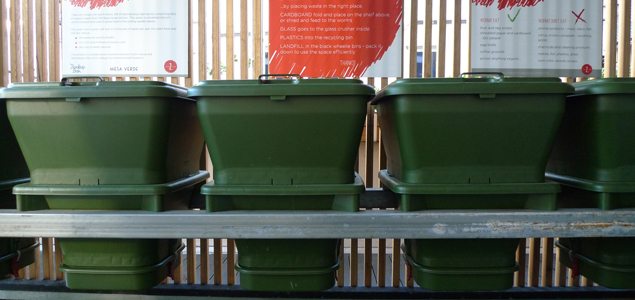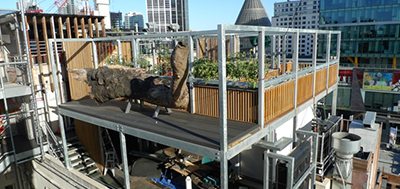Located on Level 6 of Melbourne’s Curtin House, Mexican restaurant Mesa Verde is at the forefront of sustainability in the country, having partnered with Worm Lovers founder Richard Thomas to carry out a huge eco-project on its rooftop, using Hungry Bin worm farms as its green centrepiece. Richard chats to MiNDFOOD about Mesa Verde’s game-changing garden and how you can grow your own one at home.
How did you get to be involved in worm farms?
I’m actually an ecological artist and work on all sorts of environmental projects. I’ve headed up two sustainability projects – one around forest conservation and the other around worms and composting organic waste sustainable food gardens (that’s a mouthful isn’t it). So a big part of what I do is bring all these elements – design and functionality – to come up with an integrated, sustainable design, which really came to fruition on that project because it required all these different elements to come together.
How did the relationship with Mexican restaurant, Mesa Verde, eventuate?
It kind of evolved very organically. The owner of the building wanted to redevelop the top of the building. I pitched the idea – they decided to put in Mr Verde, they also needed to upgrade their cool-room to supply the rooftop bar so I said, ‘why don’t we build a food garden and a worm farm integrated with the cool-room, so that we can actually provide passive cooling to the cool room?’
What’s involved in that process?
If the cool room is in the shade, it is probably five degrees cooler than if it were in the blazing sun, so you therefore use less electricity to cool it. And so that was the first pitch, and then we started talking about the food we were going to grow for the restaurant. Some of the herbs and things they use in the restaurant aren’t readily available in the market, so we decided we could grow some of those ingredients in the garden with the right system.
We also grow herbs for the bar as well – some of the lesser-known ones used in their cocktails, like olive bush and sage. We grow all these on the rooftop.
The other part of equation is the worm farm, so I’ve been involved with Worm Lovers for 10 years. We specialise in worm farming systems of all different scales. There are different angles to that – one of those is obviously on site organic waste management. Setting these up on site means we can process quite e a large amount of waste coming out of kitchen and turn this into high-grade food source for the garden.
How do worm farms work, exactly?
Worms are supercharged; they turn food scraps into incredible superfoods – chockablock full of nutrients and beneficial microbes that create the ideal conditions for really healthy, very robust and successful food crops. Basically, the flavours you get out of food that’s grown in worm castings is second to none – they tend to be very disease-resistant, they increase fruit cropping (you can get twice as many tomatoes from a tomato plant grown in a worm casting). The fantastic thing about it is it is pH0 neutral so you can pretty much grow any plant in it. It’s been really successful.
We don’t use any synthetic fertiliser; we don’t use any pesticides. The whole principal of biological gardens is that if the soil is healthy enough, then the plant can actually resist a lot of the pests and diseases naturally.
Could you grow a worm farm at home?
Absolutely – all of our systems are based around the Hungry Bin Worm Farm – which are available to the general public – and we ship them all over Australia. We’ve got a really good manual that comes with it – it’s probably the best worm farm you can get. It’s a new design that’s only come out the last few months, designed by a Kiwi guy – it’s on wheels so you can wheel it around. One Hungry Bin will service all the food scraps of a family of five and probably produce enough high-grade compost to fertilise a decent size vegie garden. So they are available to anyone really. There’s a bit of know-how needed – there’s a bit of training and love that needs to go into it – it is a living system after all. You do need to manage the input to get the water and nutrients and so on, but once you get it right, it’s pretty self-sustaining.
For more information on Hungry Bins and how to start your own worm farm, click here.





